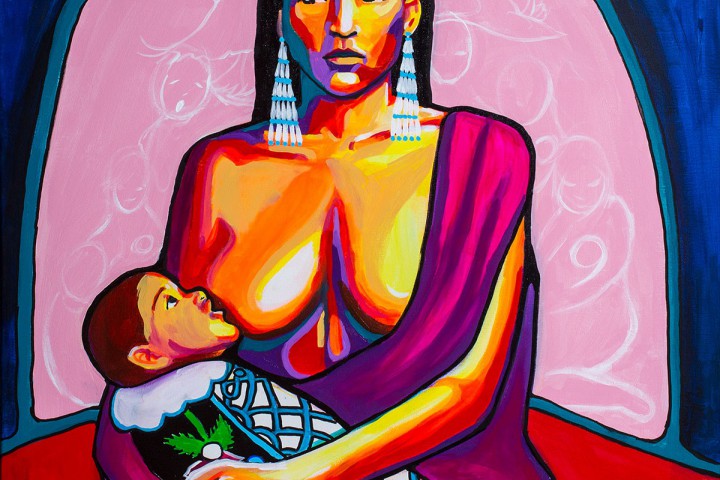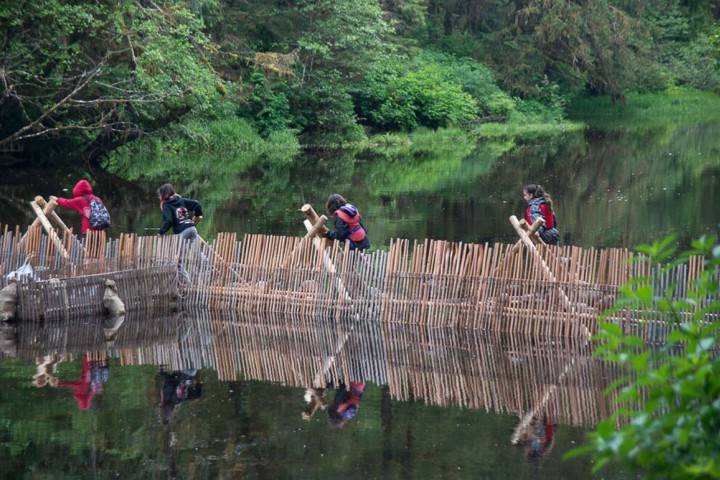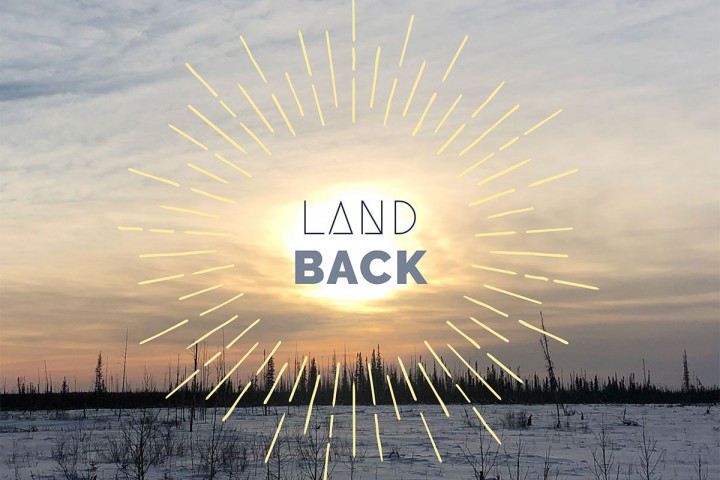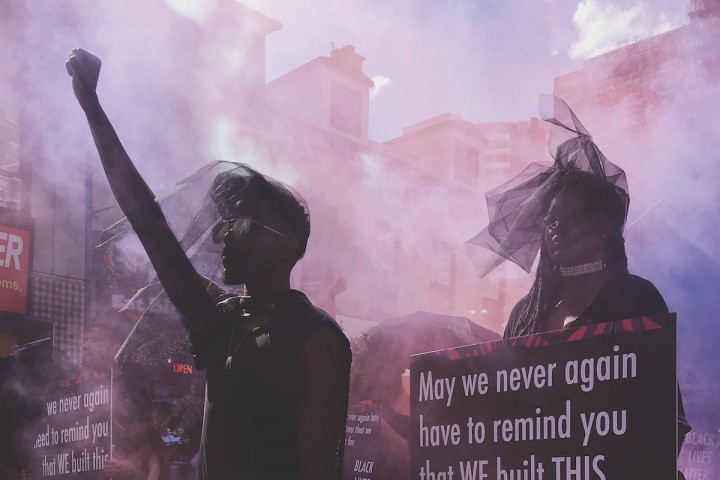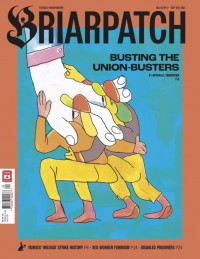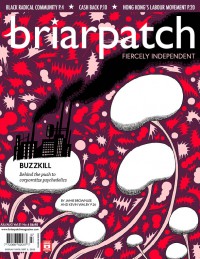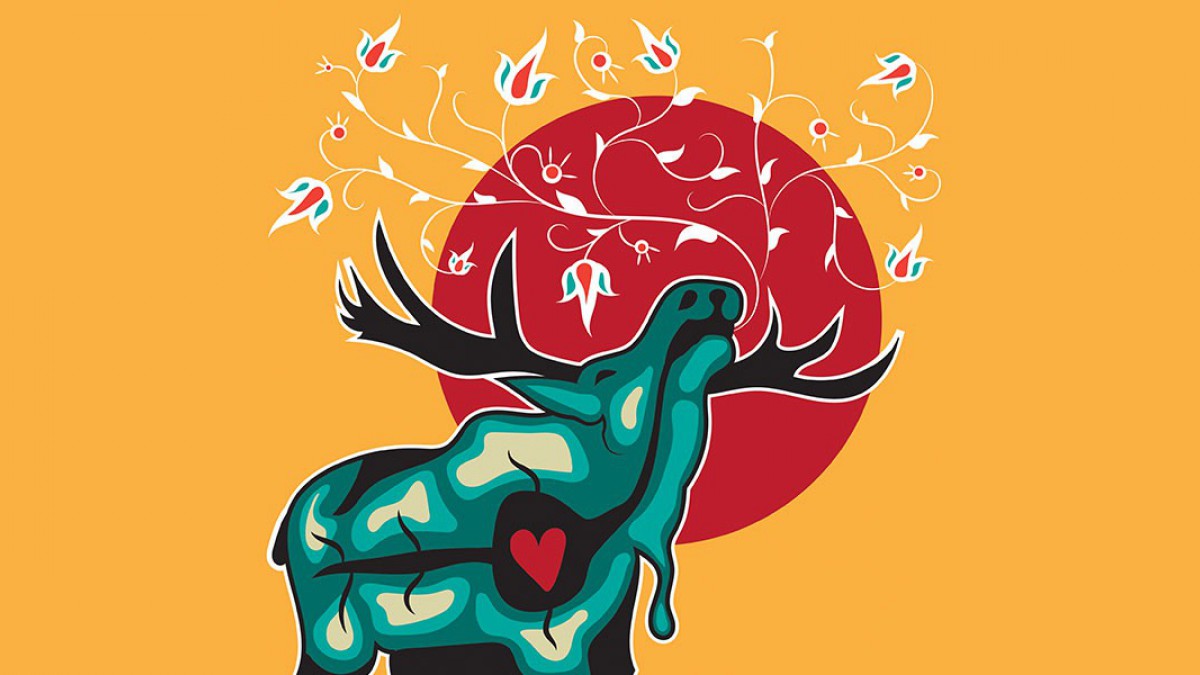
The Anishinabeg’s Call to Protect the Moose
“You want your fucking moose? I’ll show you a fucking moose!”
Those are the last words Chuck Ratt hears before a severed moose leg is thrown at him by a sport hunter who is enraged by the Indigenous blockades stopping him from entering La Vérendrye wildlife reserve in the fall of 2020.
Chuck, his wife, Tina Nottaway, and their child, Sigon, are one of the Anishinabe families who mobilized this fall to enforce a moratorium on moose hunting on their unceded Traditional Territory in the park, 300 kilometres north of Montreal.
Following the leadership of traditionalist Elders, since August 2019 the Anishinabe Nation has been demanding that the Québec Ministry of Forests, Wildlife and Parks (MFFP) stop issuing moose hunting permits in La Vérendrye for at least five years. They also called for a survey of moose populations and a co-developed stewardship program. Last year, Anishinabe land defenders set up checkpoints at the entrances to the forestry roads branching off the main highway that cuts through La Vérendrye, handing out leaflets explaining the necessity of a moratorium. This year, with too little action from the provincial government, they enforced the moratorium on their own, blocking seven roads at the height of their mobilization.
An aerial survey in January and February of 2020 confirmed what the traditionalists had known all along: Over the last 12 years, the moose population has dropped by an alarming 35 per cent.
Nottaway’s camp was one of the earliest, blocking Larouche Road on September 19, the day the 2020 hunting season would begin on her family’s territory. In a post on Facebook, she explains that the blockade is part of an age-old battle between colonial governments and the Anishinabe, who want to be able to live with dignity and on their own terms: “Where is the justice for the territories that [are] being exploited due to over hunting, logging and mining. This province doesn’t have the right to rule over the algonquin nation[.] They dont have the right to dictate our way of life[.] They dont have the right to remove us from our homeland[.] They dont own the anicinabe Title!!! Our ancestors never ceded the lands.”
The MFFP ignored the Anishinabe Nation’s 2019 call for a hunting moratorium, citing a lack of scientific evidence to prove the decline of the moose population. The Quebec Federation of Hunters and Fishers similarly insist that “the resource is not threatened” by the 90 moose that are hunted by settlers in La Vérendrye in an average year. But the members of the four Anishinabe communities in and around the 12,589 square kilometre wildlife reserve – Barriere Lake, Kitcisakik, Kitigan Zibi and Lac-Simon – know the land better than anyone. An aerial survey conducted by the ministry with some Anishinabe participants in January and February of 2020 confirmed what the traditionalists had known all along: over the last 12 years, the moose population has dropped by an alarming 35 per cent.
Hunting may be only one of the factors explaining the decline – the forestry, mining, and road building in and around the park may also contribute. “[Some] sectors of the park have log cutting 24 hours per day” remarks Casey Ratt, chief of the Algonquins of Barriere Lake, in a press release. The moose are also threatened by the human-related increase in coyote predators – including coyote-wolf hybrids – and a climate change-induced increase in winter ticks.
Quebec’s provincial police have only minimally intervened, even though angry hunters have brandished rifles, threatened to run over land defenders, and clipped one land defender with a pickup truck while trying to get past a checkpoint.
The moose leg thrown at Chuck hit him in the shoulder – luckily, he didn’t suffer a serious injury. On the front lines, tension has risen between peaceful land defenders and incensed settlers. Quebec’s provincial police have only minimally intervened, even though angry hunters have brandished rifles, threatened to run over land defenders, and clipped one land defender with a pickup truck while trying to get past a checkpoint.
Anishinabeg have also had to deal with La Vérendrye park wardens from the Société des établissements de plein air du Québec (Sépaq), the provincial agency that manages parks and wildlife reserves. Land defenders tell me that Sépaq has helped sport hunters get around the blockades by running a shuttle service through difficult quad tracks or suggesting lesser-known alternative routes. Sépaq is also offering refunds on moose hunting licences and free zone-correction permits that allow hunters to change their licence to areas that are not affected by the blockade. Even with these workarounds, many hunting convoys still showed up at the blockades demanding access throughout the hunting season.
United against a common opponent
Sporadic rumours of attacks by mobs of incensed sport hunters made for a tense but quiet atmosphere when I visit the camp. One evening, we hear that a group of over 50 hunters, gathered at the neighbouring town of Mont-Laurier, are planning to plow through the Lépine/Clova blockade, held mostly by members of Kitigan Zibi Anishinabeg, at 11 p.m. that night. Land defenders from every other blockade drive in with reinforcements. We wait for the hunters to arrive long into the cold, foggy night. People pray and smudge and hope that no shots will be fired. The riot police historically deployed to push back Anishinabe protesters in the park – like during the 2008 logging blockades – is nowhere to be seen. Thankfully, the sport hunters never show.
For Asha Meness King, an Anishinabekwe from Kitigan Zibi, the evening cements the solidarity between land defenders from the Anishinabe reserves of Kitigan Zibi and Barriere Lake: “That night it was relieving to see how fast the people from the other camps came over to help us. There [were] people of all ages, [from] youth to Elders, and we came together in strength through ceremony during that scary night,” she explains. King is part of a group of youth from Kitigan Zibi and Barriere Lake that raised funds for food, equipment, and gas at the blockade camps. “We came together through experiencing struggle together. Everyone had each other’s back,” she continues.
“I had seen such [a] divide within the Kitigan Zibi community and the [moose hunting] moratorium really let them put aside their differences and come together as a unified Nation.”
Another member of the fundraising group, Colten Jerome, agrees that solidarity was crucial to the success of the month-long blockades: “I had seen such [a] divide within the Kitigan Zibi community and the [moose hunting] moratorium really let them put aside their differences and come together as a unified Nation.” Clan feuds have been dividing families within the Anishinabe Nation for decades, but the importance of protecting an animal relative helped heal old wounds. “We all came together to protect our lands and their ecosystems, and I personally believe that this lit a fire under everyone and made them realize how we’re stronger together than apart,” Jerome adds.
For the youth at the blockades, the fight for a moose-hunting moratorium is connected to other Land Back struggles happening across the continent, like the conflict over lobster fishing in Mi’kma’ki or the fights against the Trans Mountain and Coastal GasLink pipelines by the Secwepemc, Wet’suwet’en, and Gitxsan Peoples in so-called British Columbia. Ryder Coté-Nottaway, another young Anishinabe land defender at the Lépine/Clova camp, explains, “Growing up, I’ve always been told that we are all one people. Whether you’re located in the U.S. or Canada, we are all North American Indians from Turtle Island fighting a common enemy: the government. When one of us falls, we all fall together. When one of us rises, we all rise together.”
Trophies versus sacred life
There is a profound difference between what killing a moose means to Indigenous people and to non-Indigenous people. Coté-Nottaway says that for settlers, hunting is a sport, not a necessity: “To them, the moose has no purpose or meaning other than being killed for fun.”
Sport moose hunting is part of a culture of resource extraction, and is continuous with the industrial mining and logging that’s also scarred the territory. The meat is collected like wealth is accumulated. Often, significant parts of the animal are wasted or forgotten in basement freezers. The male moose’s head, with large antlers, is displayed atop cars and hung on walls like a trophy. On the highway leading to La Vérendrye, a roadside diner has for years advertised a “concours de panache” (an antler contest), enticing hunters to compete for the biggest kill. In the nearby city of Val-d’Or, up until the 1990s, the moose festival was one of the biggest events of the year, with hunters parading corpses and decapitated heads down the main street. In his classic 1982 documentary La bête lumineuse (The Shimmering Beast), documentary filmmaker Pierre Perrault shows how the hunt can be a pretext for something else: a performance of toxic masculinity. Wives and kids are left in town while white men get together at a cabin near La Vérendrye to bully each other, get awfully drunk, and philosophize about the impossibility of men’s emotional vulnerability.
“A reoccurring response was a lot of anger due to them believing they are entitled to our land, that it belongs to them.”
When Indigenous Peoples affirm their rights, it’s an anxiety-inducing reminder to settlers that the colonial project is not complete. To claim their entitlement to the hunting grounds, settlers gathered 2,500 signatures in a petition, wrote open letters to the government, protested on the highway, and were hosted on TV and radio shows. On social media, they have hurled racist insults and death threats at land defenders. In multiple statements, the Quebec Federation of Hunters and Fishers asked for government intervention to dismantle the blockades, arguing that the blockades caused citizens “psychological distress.” King remembers how settler hunters arriving at the blockades even seemed surprised to learn that Indigenous Peoples still exist: “A reoccurring response was a lot of anger due to them believing they are entitled to our land, that it belongs to them.”
For Anishinabeg, the moose are a central part of traditional and contemporary life. Being able to care for and sustain a healthy moose population is an issue of food sovereignty; for some families, moose is a dietary staple. King explains, “Our people use every part of the animal, from the skin on their backs to their bones. We make drums, moccasins, tools such as knives, etc. The moose is sacred. They literally hold our culture within their veins.”
Coté-Nottaway adds, “Ever since I was a baby, my family has brought me to the bush. That’s where I got my teachings from. The land teaches us who we are as Anishinabeg. It has so many teachings to offer. The land teaches us how to live off of it by hunting, fishing, picking berries, making syrup. The land teaches us about our spiritual teachings, our stories and our science. The land also teaches us our responsibilities and duties. The land is our home and it’s important that we take care of our home and everything that comes with it. We have to protect it and take care of it for the future generations.”
"The moose is sacred. They literally hold our culture within their veins.”
King comes from a long line of activists. For her, land defence is an integral part of the culture: “We are taught from a young age to protect the little of what remains ours today. The land has always been very important to me because our traditional lands are being taken away from us and disrespected.” The young land defenders I spoke with hope that their struggle to protect the moose will be recognized as one that will benefit both Indigenous and non-Indigenous people.
Anishinabe chiefs have met with the ministers of Indigenous Affairs and of Forests, Wildlife and Parks, but the latter has not yet agreed to the demand for a five-year moose-hunting moratorium in La Vérendrye. Hunting permits for the 2021 season were set to be on sale in January 2021, but the date has been pushed back to March 2021. Grassroots land defenders promise to be back at the front lines in September 2021, enforcing the moratorium if the government won’t.
Update, December 29, 2020: This article originally used the spelling "Anishinaabe." While different communities use different spellings – from "Anishnabe" to "Anicinape" – the Algonquin Nation Tribal Council uses "Anishinabe" to refer to most of the communities in so-called Quebec. The article has been updated to use "Anishinabe."
Readers like you keep Briarpatch alive and thriving. Subscribe today to support fiercely independent journalism.

